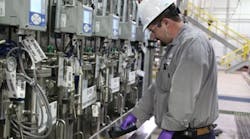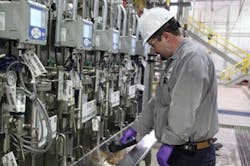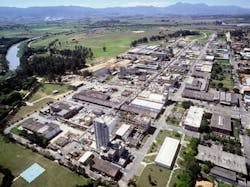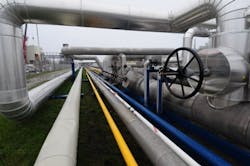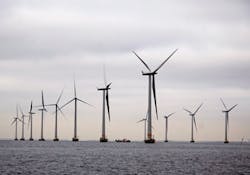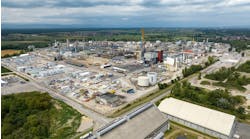The drive by some chemical companies to improve energy efficiency extends well beyond their production processes. For instance, Eastman Chemicals, BASF, AkzoNobel and Dow are working hard to find energy savings in all aspects of corporate life.
One of the main efforts of Kingsport, Tenn.-based Eastman Chemicals focuses on reliable supply of high-pressure steam for powering several large compressors for the cracker at the company’s Longview, Texas, plant. The steam comes from either an on-site cogeneration facility or less efficient boilers within the cracker operation itself. The reliability problem was highlighted one night last year when the limited turndown of the cogeneration facility forced the shutdown of one of its two combustion turbines. This reduced the reliability of the high-pressure steam supply, causing the cracker to produce the steam using its own boilers.
To solve this problem, the company has installed novel burner technology in the two cogeneration combustion turbines. This greatly increases their turndown, allowing both to remain online at all times.
“This improved steam reliability to the point that high-pressure steam production could be shifted from the cracker to the cogeneration plant. The two units worked together to reduce the cracker boilers use and increase the steam from the cogeneration plant. Controls were installed to control the steam header pressure while minimizing steam produced by the boilers. In all, the project will save 156,000 MMBTU/y,” explains Sharon Nolen, Eastman’s manager, global natural resources management.
Figure 1. Operator collects data at previously idled steam plant that has been converted to fire natural gas instead of coal. Source: BASF.
Since 2012, Eastman has been collaborating with Purdue University, West Lafayette, Ind., and the Process Science and Technology Center at the University of Texas, Austin, in an ongoing effort to improve the energy efficiency of its energy-intensive distillation units using dividing-wall column technologies. To date, Eastman has committed over $1.5 million in funding to the project.
“Distillation accounts for roughly 40% of all energy consumed by industrial chemical processes. Our efforts thus far have shown that new distillation schemes/technology can reduce the energy consumption by up to 50% and the capital investment by over 30%,” notes Scott Owens, Eastman’s scale-up project leader.
The academic collaborators currently are evaluating system selection, column design/construction, process simulation and operation/control of new distillation technology.
“This work gave us a significant jumpstart on our internal efforts to add or upgrade experimental facilities and understand and apply the new technologies to our own proprietary processes. We have already identified several processes which would see large financial benefits from retrofitting to a more-advanced distillation technology. In many cases, the process would enable reduced energy intensity and line expansion with minimal capital investment,” he adds.
The company also is tackling non-process-related energy inefficiencies. For instance, a project to upgrade lighting is underway at various company sites, building on ongoing efforts at the Kingsport headquarters. “The majority of installations involve replacing less efficient lighting with LEDs [light-emitting diodes]. Energy savings for 2016 equate to more than $390,000,” says Lisa Lambert, Tennessee site energy coordinator.
Broad Energy Certification
For its part, BASF, Ludwigshafen, Germany, is committed to achieving certification to the ISO-50001 energy management standard by 2020 for the sites that account for 90% of its total purchased energy. It also aims to increase energy efficiency in its production plants by 35% by the same year (2002 baseline).
In North America, this so far has involved the implementation of 14 energy efficiency projects at seven different production sites.
Among these is a project at its Wyandotte, Mich., complex. In 2014, site management learned that Wyandotte Municipal Services would stop providing steam to the site after 2016. After evaluating nine different options, the site decided to reactivate a large steam plant that had stood idle for more than a decade. Over the next two years, a project team converted the plant, which originally was coal-fired, to natural gas. This involved installing high-efficiency natural gas burners, a new control system and water-treatment system, enhancing the plant’s electrical infrastructure, and hiring a team of ten employees to run the unit. The steam plant began operating at the end of last year (Figure 1).
“The project at our Wyandotte site exemplifies our strategic approach to integrate energy management goals into our efforts to optimize our processes at BASF,” stresses Ty Geiger, vice president of energy management, BASF, Houston. “It is for these efforts that BASF has been recognized by the American Chemistry Council for its energy efficiency improvements for 20 consecutive years,” he adds.
Efforts, of course, are taking place worldwide. For instance, BASF has been implementing a “triple E” (excellence in energy efficiency) project at its Guaratinguetá complex in Brazil where 12 plants with a total capacity of over 260,000 t/y manufacture more than 750 different products (Figure 2).
Figure 2. Energy efficiency projects at Guaratinguetá, Brazil, site range from processes to lighting to even locker-room hot water. Source: BASF.
One project focused on installing a new heat exchanger to recover heat from a sodium methylate product that is used as a catalyst in biodiesel production. This saved the company 730 t/y of steam and had a return on investment (ROI) of 18 months.
Another involved replacing old, largely sodium and mercury, lamps with 450 LED lamps. This increased lamp service life to 80,000 h from 10,000 h and reduced energy consumption by 75% or 620 MWh/y. The ROI here was 27 months.
A third project centered on replacing the water heating system for locker rooms. It had been consuming 840 t/y of steam to heat 12,000 m3/y of water. Switching to solar panels and introducing water flow reducers resulted in a 2,700 m3/y saving in water consumption, lower energy consumption and an ROI of 35 months.
With these and other initiatives, BASF has cut energy consumption by 7.098 MWh/y at the complex, saving R$ 6.46 million/y ($2.07 million/y) in energy costs and reducing carbon dioxide emissions by 705 t/y.
Renewable Power Emphasis
AkzoNobel, Amsterdam, particularly is focusing its energy efficiency initiatives on developing renewable power options.
For example, a new contract with Swedish energy company Vattenfall will enable AkzoNobel to ramp up the supply of renewable electricity to its facilities in Sweden and Finland. Hydro and wind power already make up the majority of the electricity supplied by Vattenfall; the two companies have agreed to further increase the share of renewable energy to the facilities to 100% by 2020. The contract supplies AkzoNobel with 1.25 TWh/y of electricity to power six specialty chemicals sites and one performance coatings facility. In addition, the agreement allows the two companies to work together to balance swings in renewable power supply on the Swedish national grid.
Meanwhile at its chemical park in Delfzijl, the Netherlands, AkzoNobel is switching to sustainable steam use (Figure 3). The company, along with Eneco and Groningen Seaports jointly have invested around €40 million ($47 million) in a project to convert an existing biomass plant into a combined heat and power plant. When fully commissioned, the project will help improve the long-term competitiveness of the Delfzijl plants and ensure that an additional 10% of the company’s energy consumption in the Netherlands comes from renewable sources — cutting 100,000 t/y of carbon dioxide emissions in the process.
Figure 3. Steam now comes from an existing biomass unit that was converted into a combined heat and power plant. Source: AkzoNobel.
AkzoNobel also is heading a consortium that includes Philips, Amsterdam; DSM, Heerlen, the Netherlands; and Google’s Amsterdam facility, to purchase green electricity from two new wind parks at Bouwdokken and Krammer, both in the Netherlands (Figure 4). These wind parks currently supply 140 MW of power; the consortium members now are investigating other opportunities for sustainable energy cooperation and working with banks and equity investors on novel funding processes for them.
Further afield, AkzoNobel has integrated its production facilities in Imperatriz, Brazil, directly with the neighboring Suzano Maranhão pulp mill. One benefit here is being able to source energy directly from waste wood left over after eucalyptus trees are processed.
“Our pathway to renewable energy means going beyond the immediate business, working with others to create a wider change in society. That’s the pathway we want to speed up. Partnerships will play a key role and we are at the forefront of working together with others to help the world move towards renewable energy quicker,” notes AkzoNobel’s corporate director of sustainability Andre Veneman.
Figure 4. Dutch consortium is purchasing energy from this and another wind park in The Netherlands. Source: AkzoNobel.
Water-Based Savings
For Dow, Midland, Mich., a major focus is on developing energy-efficiency-improving technologies that can be leveraged for use on multiple sites. Many of these center on water use.
For example, at its Terneuzen site in the Netherlands, the company at one point was using thermally desalinated water to balance the competing demands of the plant, agriculture and the neighboring community. Dow now relies on wastewater recycled from the local municipality to generate plant steam and process water and reuses condensate in cooling towers.
“So successful was the initiative that by 2020 Dow hopes to have expanded [the] amount we use from 10,000 m3/d to 30,000 m3/d. This 2020 initiative will lower the energy costs by 95% and has led to the expansion of other local municipal projects,” notes Denise Haukkala, technical service expert, Dow Water & Process Solutions North America, San Francisco.
One of these is at Dow’s complex in Tarragona, Spain, where the wastewater from three local cities now is being treated with a combination of Veolia and Dow Filmtec technologies.
“It’s led to a very real savings in the ethylene cracker cooling towers. Using up to 40% reused water has reduced blowdown by 49% and chemical usage by 23%. Using RO [reverse osmosis] processes means that the cooling makeup water can be used in 5–10 more cycles, with reduced need for chemical additives. So it’s a multiplier effect — adding extra cycles substantially reduces tower flow demand, together with the need for scale, corrosion and antimicrobial chemical additives,” she adds.
At Tarragona, Veolia technology serves for pre-treatment, with the water then going through Dow extra-fouling-resistant membranes in the system’s first pass and then its low-energy membranes in the second pass. The design of the second pass has helped the plant deliver higher salt rejection at 33% lower pressure, reducing overall energy usage.
Looking to the future, Haukkala believes that the next innovations in water-related energy efficiency are going to come in the areas of high-temperature RO and nanofiltration. “How about being able to treat condensate overhead water or various process waste waters at 50–80°C and reuse that product water back into the process without adding costly heat exchangers?” she asks.
